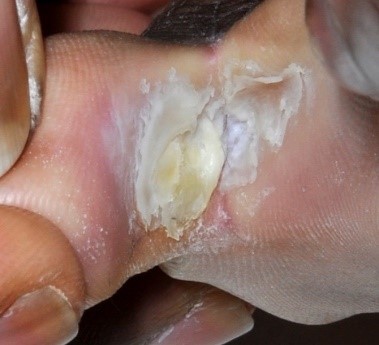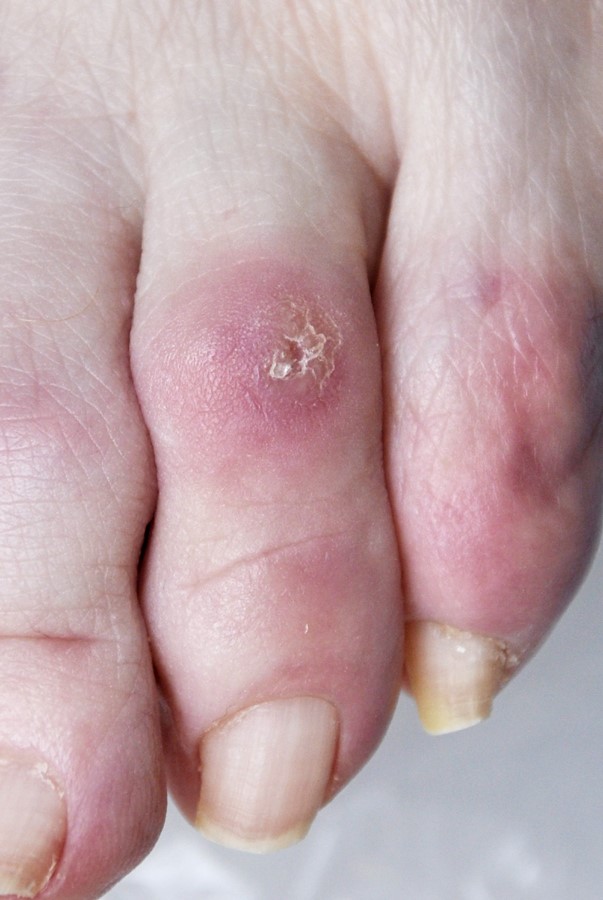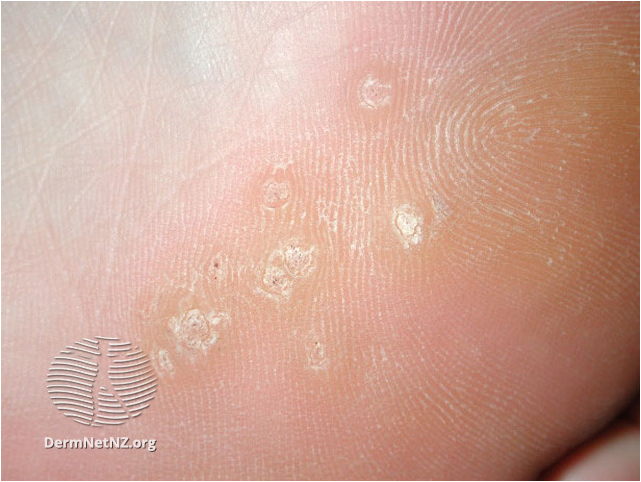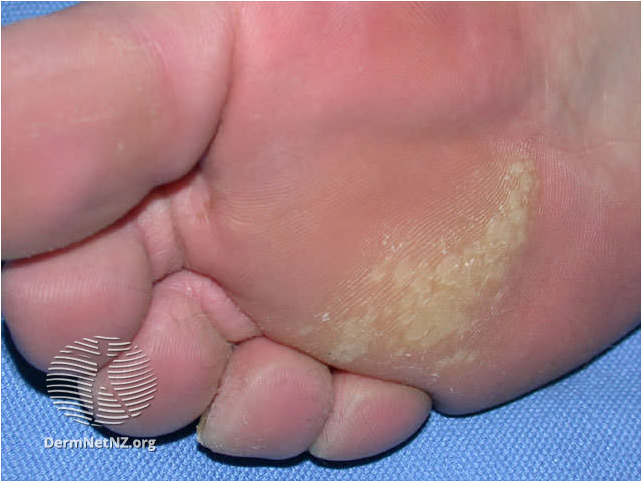Callous
An extended area of thickened, hard skin on the sole of the foot. It is usually symptomatic of an underlying problem such as a bony deformity, a particular style of walking or inappropriate footwear. Some people have a natural tendency to form callous because of their skin type. Elderly people have less fatty tissue in their skin and this can lead to callous forming on the ball of the foot

Soft Corns
Occur between the toes and usually caused by pressure and by the toes rubbing together. They appear white and rubbery / macerated because of too much moisture in the interdigital space. This is usually from sweat or from not drying well enough between the toes.
image copyright NHS Lothian

Hard Corns
Localised thickened callouses at areas of high pressure. They normally present as a circumscribed yellow hardened mass. Removal of overlying hyperkeratosis shows the darker coloured nucleus. They are common over bony prominences for example: on the tops of toes or on the balls of feet.
image copyright NHS Lothian

Verrucae
Verrucae are plantar warts that commonly occur on the soles of the feet or around the toe area. They are caused by the Human Papilloma Virus (HPV), which is contagious through direct person-to-person contact. Well-defined rounded lesions with overlying hard skin. Can become painful if on weight-bearing area. There is visible disruption of skin striations
image from Search DermNet | DermNet (dermnetnz.org)

Mosaic Verrucae
Mosaic verrucae result from a plaque of closely grouped warts. They tend not to be painful. They can appear anywhere on the feet. They have cauliflower-like appearance, often with black dots at the centre – these are blood vessels. There can be a layer of overlying callus present on the surface. They can spread over large areas of the foot and individual lesion can grow to 1cm in diameter.
image from Search DermNet | DermNet (dermnetnz.org)
Chilblain
Chilblains are small itchy, red (and sometimes purple) swellings on the skin, which can become increasingly painful, swell and dry out leaving cracks in the skin that expose the foot to the risk of infection. They occur on the toes (particularly the smaller ones), fingers, the face (especially the nose) and the lobes of the ears. They can also occur on areas of the feet exposed to pressure, for instance on a bunion or where the second toe is squeezed by tight shoes. They can also lead to blisters and break down to become a small ulcer prone to infection.
M.A. & L.S. 11-07-24
Referral Criteria:
Callus/corns
- Consider referral to Podiatry if self-management has failed and the patient is experiencing pain that is affecting their ability to complete their normal daily activities.
- If there is underlying extravasation / bleeding / very dark discolouration.
Verrucae
- Diagnostic uncertainty
- Lesion is very painful and is severely affecting patient’s daily activities.
- Ulcer management is required due to secondary bacterial infection or severe side effects from salicylic acid treatment.
Chilblains
- If the chilblain has ulcerated
Who not to refer:
- Minor callous and verrucae which are asymptomatic
- We do not offer routine treatment for verrucae.
- Consider referral to podiatry if pain is associated with heavy callus build up and lesion is located on a weight-bearing area. NOTE: one-off appointment can be offered for sharp debridement.
- Fungal skin and nail infections
See resources and links for patient information leaflets
NHS Lothian Podiatry Patient Information Leaflets
- Chilblains (nhslothian.scot)
- Athlete’s Foot (nhslothian.scot)
- Verrucae (nhslothian.scot)
- Personal Foot Care (nhslothian.scot)
Royal College of Podiatry
Corns/Callus: Royal College of Podiatry (rcpod.org.uk)
Verrucae: Royal College of Podiatry (rcpod.org.uk)
Chilblains: Royal College of Podiatry (rcpod.org.uk)
NHS inform: https://www.nhsinform.scot/illnesses-and-conditions/skin-hair-and-nails/warts-and-verrucas/
British Association of Dermatologists website: www.skinhealthinfo.org.uk/condition/plantar-warts/













